|
FORD MUSTANG History
Introduction: The
date was April 17, 1964. Intermediate sized muscle cars, with big block
engines were gradually replacing the fullsized muscle car. Lee Iacocca,
Ford's General Manager, had always invisioned a small sports car to be
the next hot item in the street wars. Ford decided that instead of improving
their lackluster intermediate, they would do the competition one better
and introduce a whole new breed of automobile, the pony car. Originally
designed as a two seater in the European tradition, Iacocca realized that
true success depended on volume sales. Therefore the Ford Mustang was introduced
as a 1965 model that was based on the compact Falcon to lower production
costs. It came with an obligatory back seat and a multitude of options
that would give the buyer an opportunity to customize their purchase, and
generate extra profits for Ford. Plymouth faithful stress that their Baracuda
beat the Ford Mustang to market by two weeks. But it was the Mustang, which
racked up over one million sales in its first two years, that turned the
market and people's attention to the pony car. The pony car class that
the Ford Mustang helped create is the only class of muscle car that still
exists today.
1965 Ford Mustang
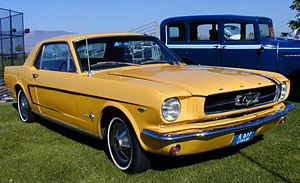 Comments:
The Ford Mustang debuted as a simple sports car powered by a 170 cid six
cylinder and a pair of V8's. Originally named for the fighter plane, the
P-51 Mustang, preliminary allusions were made to the horse, and the horse
motiff quickly became the emblem for the Mustang. Buyers loved its low
price, long hood, short trunk styling, and its myriad of options. Ford
loved its high volume sales and visibility. In mid 1964, Ford introduced
a sporty 2+2 fastback body style to go along with the hardtop coupe and
convertible. Enthusiasts also cheered the new "K-code" 271bhp 289 cid V8
that finally put some performance to match the Mustang's good looks. For
those that wanted more, the legendary Carroll Shelby and Ford collaborated
to produce the Shelby GT-350, a Ford Mustang fastback specially tuned by
Shelby. The 289 V8 produced 306bhp in street tune and around 360bhp in
special GT-350R race tune. These Shelby's had no back seat, were only available
in white and were fully race ready. Comments:
The Ford Mustang debuted as a simple sports car powered by a 170 cid six
cylinder and a pair of V8's. Originally named for the fighter plane, the
P-51 Mustang, preliminary allusions were made to the horse, and the horse
motiff quickly became the emblem for the Mustang. Buyers loved its low
price, long hood, short trunk styling, and its myriad of options. Ford
loved its high volume sales and visibility. In mid 1964, Ford introduced
a sporty 2+2 fastback body style to go along with the hardtop coupe and
convertible. Enthusiasts also cheered the new "K-code" 271bhp 289 cid V8
that finally put some performance to match the Mustang's good looks. For
those that wanted more, the legendary Carroll Shelby and Ford collaborated
to produce the Shelby GT-350, a Ford Mustang fastback specially tuned by
Shelby. The 289 V8 produced 306bhp in street tune and around 360bhp in
special GT-350R race tune. These Shelby's had no back seat, were only available
in white and were fully race ready.
Production: 2D Hardtop:
501,965 Convertible: 101,945 Fastback: 77,079
Engines: 170 I6 101bhp.
200 I6 120bhp. 260 V8 164bhp. 289 V8 225bhp. 289 V8 271bhp. (GT-350) 289
V8 306bhp. (GT-350R) 289 V8 360bhp.
1966 Ford Mustang
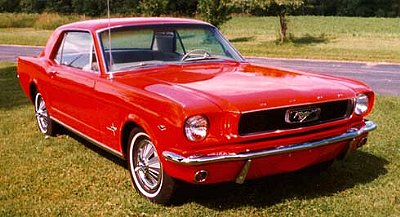 Comments:
1966 saw further refinement of the Mustang. The gauge cluster was redone
to seperate the Mustang from its Falcon roots while the 260 cid V8 was
replaced with 2 and 4 barrel versions of the 289 cid V8. The Shelby GT-350
was still available, though its race image was being dilluted by the addition
of an automatic transmission, a choice of four colors, and special examples
that were prepared for Hertz Rent A Car (known as Shelby GT-350H) for rental
to weekend drag racers. Available on the GT-350 through 1968 was a Paxton
supercharger which would boost horsepower by as much as 40%. Comments:
1966 saw further refinement of the Mustang. The gauge cluster was redone
to seperate the Mustang from its Falcon roots while the 260 cid V8 was
replaced with 2 and 4 barrel versions of the 289 cid V8. The Shelby GT-350
was still available, though its race image was being dilluted by the addition
of an automatic transmission, a choice of four colors, and special examples
that were prepared for Hertz Rent A Car (known as Shelby GT-350H) for rental
to weekend drag racers. Available on the GT-350 through 1968 was a Paxton
supercharger which would boost horsepower by as much as 40%.
Production: 2D Hardtop:
499,751 Convertible: 72,119 Fastback: 35,698
Engines: 200 I6 120bhp.
289 V8 200bhp. 289 V8 225bhp. 289 V8 271bhp. (GT-350) 289 V8 306bhp. (GT-350R)
289 V8 360bhp.
1967 Ford Mustang
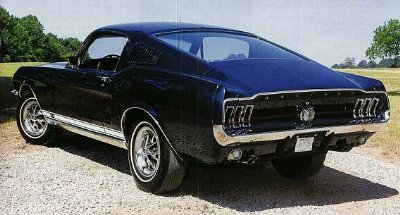 Comments:
1967 saw a massive restyle of the Ford Mustang. Changes included bulkier
sheetmetal below the beltline, a more aggressive grille, a concave tail
panel, and a full fastback roofline for the fastback body style. The engine
compartment was also increased and Ford dropped in its big block 390 to
compete against the new Chevrolet Camaro SS396. Although the 390 was slightly
detuned for the Mustang, its popularity sealed the end of the high performance
289 cid engine, which was later dropped from the lineup. Of greater interest
to enthusiasts was the availablitity of another Shelby-tuned Mustang. The
GT350 was still powered by a modified 289 V8, though output dropped to
290bhp. The new GT500 was powered by a reworked 428 V8 (some were reportedly
built with the even more powerful, race ready 427 V8). The 1967 Shelby's
were more civilized and sported numerous luxury options, which seemed to
appeal to buyers. These would be the last Shelby Mustangs actually built
by Shelby-American. All future models would be built by Ford with little
Shelby involvement. Comments:
1967 saw a massive restyle of the Ford Mustang. Changes included bulkier
sheetmetal below the beltline, a more aggressive grille, a concave tail
panel, and a full fastback roofline for the fastback body style. The engine
compartment was also increased and Ford dropped in its big block 390 to
compete against the new Chevrolet Camaro SS396. Although the 390 was slightly
detuned for the Mustang, its popularity sealed the end of the high performance
289 cid engine, which was later dropped from the lineup. Of greater interest
to enthusiasts was the availablitity of another Shelby-tuned Mustang. The
GT350 was still powered by a modified 289 V8, though output dropped to
290bhp. The new GT500 was powered by a reworked 428 V8 (some were reportedly
built with the even more powerful, race ready 427 V8). The 1967 Shelby's
were more civilized and sported numerous luxury options, which seemed to
appeal to buyers. These would be the last Shelby Mustangs actually built
by Shelby-American. All future models would be built by Ford with little
Shelby involvement.
Production: 2D Hardtop:
356,271 Convertible: 44,808 Fastback: 71,042
Engines: 200 I6 115bhp.
200 I6 120bhp. 289 V8 195bhp. 289 V8 271bhp. (Shelby GT350) 289 V8 290bhp.
390 V8 320bhp. 390 V8 325bhp. (Shelby GT500) 428 V8 355bhp@5400rpm, 420lb-ft@3200rpm.
Performance: (Shelby
GT500) 428/355: 0-60 in 6.2 sec, 1/4 mile in 14.6 sec @ 99mph.
1968 Ford Mustang
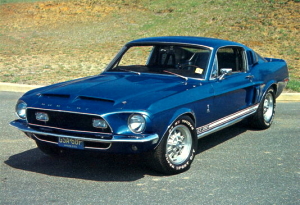 Comments:
The 1968 Ford Mustang received a simpler grille and side trim and a limited
number of 427 engines were slipped into the engine bays. These 427 engines
were slightly detuned but still cranked out 390bhp, enough to strike fear
on the streets. Then on April 1, 1968, Ford unveiled perhaps its most famous
line of engines, the 428 Cobra Jet. It was based on the regular 428 but
included larger valve heads, the race 427's intake manifold, and an oil-pan
windage tray. It had ram-air induction and breathed through a functional
hood scoop. Output was listed at 335bhp but was rumoured to be around 410bhp.
The Shelby's were still available, joined by an available convertible model
and renamed the Shelby Cobra. The GT-350 dropped its 289 cid 306 bhp engine
and gained a 302 cid 250bhp engine. Midway through the year, the GT-500
was dropped and was replaced by the GT-500KR ("King of the Road"). The
GT-500KR sported the new Ram Air 428 Cobra Jet, still underrated at 335bhp. Comments:
The 1968 Ford Mustang received a simpler grille and side trim and a limited
number of 427 engines were slipped into the engine bays. These 427 engines
were slightly detuned but still cranked out 390bhp, enough to strike fear
on the streets. Then on April 1, 1968, Ford unveiled perhaps its most famous
line of engines, the 428 Cobra Jet. It was based on the regular 428 but
included larger valve heads, the race 427's intake manifold, and an oil-pan
windage tray. It had ram-air induction and breathed through a functional
hood scoop. Output was listed at 335bhp but was rumoured to be around 410bhp.
The Shelby's were still available, joined by an available convertible model
and renamed the Shelby Cobra. The GT-350 dropped its 289 cid 306 bhp engine
and gained a 302 cid 250bhp engine. Midway through the year, the GT-500
was dropped and was replaced by the GT-500KR ("King of the Road"). The
GT-500KR sported the new Ram Air 428 Cobra Jet, still underrated at 335bhp.
Production: 2D Hardtop:
249,447 Convertible: 25,376 Fastback: 42,581
Engines: 200 I6 115bhp.
200 I6 120bhp. 289 V8 195bhp. 289 V8 271bhp. 302 V8 230bhp. (Shelby Cobra
GT-350) 302 V8 250bhp. 390 V8 320bhp. 390 V8 325bhp. 427 V8 390bhp. (Cobra
Jet) 428 V8 335bhp@5400rpm (est. 410bhp), 440lb-ft@3400rpm. (Shelby Cobra
GT-500) 428 V8 350bhp.
Performance: (Cobra
Jet) 428/335: 0-60 in 5.4 sec, 1/4 mile in 14.01@101mph.
1969 Ford Mustang
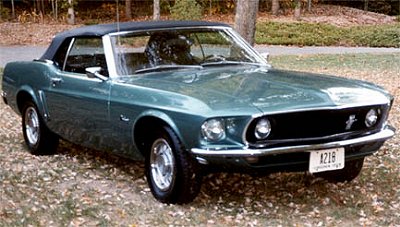 Comments:
The Mustang was restyled for 1969, gaining 3.8 inches of length, all ahead
of the front wheels, and about 140 lbs in curb weight. The Mach 1 body
style debuted in 1969 and came standard with a 351 cid V8 but could also
be had with the 428 Cobra Jet, which now came in three states of tune.
The first was a non-Ram Air version, followed by the Ram-Air version which
breathed through a shaker hood scoop. Topping the list was the new Super
Cobra Jet which came with the Drag Pack option. The Super Cobra Jet used
the shaker hood scoop, a modified crankshaft and stronger connecting rods.
The Drag Pack also came with limited-slip 3.91:1 or 4.30:1 rear axles and
no air conditioning. All three engines were underrated at 335bhp. All this
power overwhelmed the rear tires, which suffered from a 59/41% f/r bias
which also hurt handling. But then, these Mustangs weren't built for curves,
just straight 1/4 mile lines. The circle tracks were reserved for the Boss
series of Mustangs. Named after stylist Larry Shinoda's nickname for Ford
president Semon "Bunkie" Knudson, the Boss Mustangs were built to qualify
the 429 V8 for NASCAR. The Boss 429 package came with a race ready 429
cid V8 with ram air induction, an aluminum high riser and header type exhaust
manifolds. Mandatory options included a four speed manual and a 3.91:1
Traction-Lok axle. Also included were an oil cooler, trunk mounted battery,
race suspension, and the best interior Mustang had to offer. Although impressive
on paper, the Boss 429s failed on the street where their dependence on
high revs hurt their street starts and the initial batch had incorrect
valve springs that would stop winding at 4500rpm instead of 6000rpm. Nevertheless,
it had good handling and would last through 1970. To combat Chevrolet's
Camaro Z/28 in Trans Am racing, Ford built the Boss 302 which used a 302
cid V8 treated to the cylinder heads from the racing 351 cid engine and
Ford's largest carb. It was underrated at the same 290bhp as the Camaro
Z/28's engine and was available with the shaker hood scoop. Shelby Mustangs
were still available, though they were more luxury oriented then ever before. Comments:
The Mustang was restyled for 1969, gaining 3.8 inches of length, all ahead
of the front wheels, and about 140 lbs in curb weight. The Mach 1 body
style debuted in 1969 and came standard with a 351 cid V8 but could also
be had with the 428 Cobra Jet, which now came in three states of tune.
The first was a non-Ram Air version, followed by the Ram-Air version which
breathed through a shaker hood scoop. Topping the list was the new Super
Cobra Jet which came with the Drag Pack option. The Super Cobra Jet used
the shaker hood scoop, a modified crankshaft and stronger connecting rods.
The Drag Pack also came with limited-slip 3.91:1 or 4.30:1 rear axles and
no air conditioning. All three engines were underrated at 335bhp. All this
power overwhelmed the rear tires, which suffered from a 59/41% f/r bias
which also hurt handling. But then, these Mustangs weren't built for curves,
just straight 1/4 mile lines. The circle tracks were reserved for the Boss
series of Mustangs. Named after stylist Larry Shinoda's nickname for Ford
president Semon "Bunkie" Knudson, the Boss Mustangs were built to qualify
the 429 V8 for NASCAR. The Boss 429 package came with a race ready 429
cid V8 with ram air induction, an aluminum high riser and header type exhaust
manifolds. Mandatory options included a four speed manual and a 3.91:1
Traction-Lok axle. Also included were an oil cooler, trunk mounted battery,
race suspension, and the best interior Mustang had to offer. Although impressive
on paper, the Boss 429s failed on the street where their dependence on
high revs hurt their street starts and the initial batch had incorrect
valve springs that would stop winding at 4500rpm instead of 6000rpm. Nevertheless,
it had good handling and would last through 1970. To combat Chevrolet's
Camaro Z/28 in Trans Am racing, Ford built the Boss 302 which used a 302
cid V8 treated to the cylinder heads from the racing 351 cid engine and
Ford's largest carb. It was underrated at the same 290bhp as the Camaro
Z/28's engine and was available with the shaker hood scoop. Shelby Mustangs
were still available, though they were more luxury oriented then ever before.
Production: Mach
1: 72,458 Convertible: 14,746 Grande Hardtop Coupe: 22,182 Boss 302: 1,934
Boss 429: 858
Engines: 200 I6 115bhp.
250 I6 155bhp. 302 V8 220bhp. (Boss 302) 302 V8 290bhp@5800rpm, 290lb-ft@4300rpm.
351 V8 250bhp. (All Cobra Jets) 428 V8 335bhp@5200rpm, 440lb-ft@3400rpm.
(Boss 429) 429 V8 375bhp@5200rpm, 450lb-ft@3400rpm.
Performance: (Super
Cobra Jet) 428/335: 0-60 in 5.7 sec, 1/4 mile in 13.9 sec @ 103mph. (Boss
429) 429/375: 0-60 in 6.8 sec, 1/4 mile in 14.0 sec @ 103mph.
1970 Ford Mustang
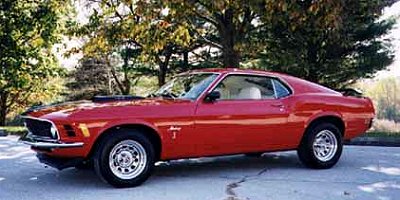 Comments:
Both the Boss 302 and 429 continued into 1970. New for 1970 was the replacement
of the 428 Cobra Jet with the 429 Cobra Jet. The 429 Cobra Jet was rated
at 370bhp while the Super Cobra Jet was rated for 375bhp. This would be
the last year for the Shelby Cobras, which were in fact left over 1969
models. A not so great end for a once great performer. Comments:
Both the Boss 302 and 429 continued into 1970. New for 1970 was the replacement
of the 428 Cobra Jet with the 429 Cobra Jet. The 429 Cobra Jet was rated
at 370bhp while the Super Cobra Jet was rated for 375bhp. This would be
the last year for the Shelby Cobras, which were in fact left over 1969
models. A not so great end for a once great performer.
Production: Mach
1: 40,970 Convertible: 7,643 Grande Hardtop Coupe: 13,581 Boss 302: 6,318
Boss 429: 498
Engines: 200 I6 115bhp.
250 I6 155bhp. 302 V8 220bhp. (Boss 302) 302 V8 290bhp@5800rpm, 290lb-ft@4300rpm.
351 V8 250bhp. 351 V8 300bhp. (Cobra Jet) 429 V8 370bhp. (Super Cobra Jet)
429 V8 375bhp. (Boss 429) 429 V8 375bhp@5200rpm, 450lb-ft@3400rpm.
Performance: (Boss
302) 302/290: 0-60 in 6.5 sec, 1/4 mile in 14.8 sec @ 96 mph.
1971 Ford Mustang
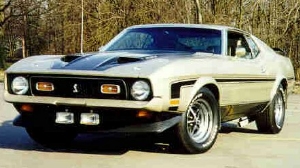 Comments:
Ford's decade of "Total Performance" was drawing to a close. The Mustang
grew by 2.1" of length, 2.8" of width, 1" of wheelbase, and about 100 lbs.
Coupled with this weight gain was the disappearance of the Shelby models
and the Boss 302 and Boss 429 models, and the weakening of the remaining
engine choices. The 351 engine was detuned from 300 bhp to 285bhp while
the 429 Cobra Jet dropped 5bhp to 370bhp. The performance banner was carried
by the Mach 1 Mustang and the new Boss 351 model. The standard engine for
the Mach 1 was the 351 Cleveland V8 with 285bhp but a 330bhp version was
also available. The 429 Cobra Jet sported 370bhp while the top power choice
was was the 429 Super Cobra Jet Ram Air. It had 11.3:1 compression, and
generated 375bhp but its 1/4 mile times were slower than the Boss 351.
The Boss 351 enjoyed a lower weight and a race bred 351 engine that had
a radical solid-lifter cam, 11.0:1 compression, ram-air induction and came
with a Hurst four-speed transmission and 3.91:1 Traction-Lok differential.
This would be its only season as Ford performance would continue to decrease. Comments:
Ford's decade of "Total Performance" was drawing to a close. The Mustang
grew by 2.1" of length, 2.8" of width, 1" of wheelbase, and about 100 lbs.
Coupled with this weight gain was the disappearance of the Shelby models
and the Boss 302 and Boss 429 models, and the weakening of the remaining
engine choices. The 351 engine was detuned from 300 bhp to 285bhp while
the 429 Cobra Jet dropped 5bhp to 370bhp. The performance banner was carried
by the Mach 1 Mustang and the new Boss 351 model. The standard engine for
the Mach 1 was the 351 Cleveland V8 with 285bhp but a 330bhp version was
also available. The 429 Cobra Jet sported 370bhp while the top power choice
was was the 429 Super Cobra Jet Ram Air. It had 11.3:1 compression, and
generated 375bhp but its 1/4 mile times were slower than the Boss 351.
The Boss 351 enjoyed a lower weight and a race bred 351 engine that had
a radical solid-lifter cam, 11.0:1 compression, ram-air induction and came
with a Hurst four-speed transmission and 3.91:1 Traction-Lok differential.
This would be its only season as Ford performance would continue to decrease.
Production: Mach
1: 36,499 Convertible: 6,121 Boss 351: Estimated 1,800
Engines: 250 I6 145bhp.
302 V8 210bhp. 351 V8 240bhp. 351 V8 285bhp. (Boss 351) 351 V8 330bhp@5400rpm,
370lb-ft@4000rpm. (Cobra Jet) 429 V8 370bhp. (Super Cobra Jet) 429 V8 375bhp,
450lb-ft.
Performance: (Boss
351) 351/330: 0-60 in 5.8 sec, 1/4 mile in 13.9 sec @ 102 mph.
1972 Ford Mustang
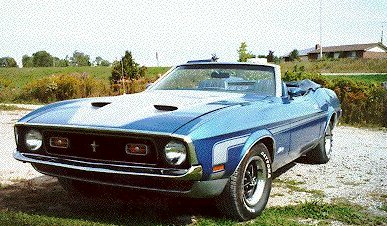 Comments:
Following industry lead, all power ratings for 1972 and later were listed
in net ratings which included all accessories. This lead to some drastic
drops in power listings which, coupled with the drop of all big block options,
sealed the end of Ford Mustang performance. The Boss 351 was dropped leaving
only the Mach 1 with any claim to performance. The top engine option was
just a 275bhp 351 Cleveland. Comments:
Following industry lead, all power ratings for 1972 and later were listed
in net ratings which included all accessories. This lead to some drastic
drops in power listings which, coupled with the drop of all big block options,
sealed the end of Ford Mustang performance. The Boss 351 was dropped leaving
only the Mach 1 with any claim to performance. The top engine option was
just a 275bhp 351 Cleveland.
Production: Mach
1: 27,675 Convertible: 6,401
Engines: 250 I6 99bhp.
302 V8 141bhp. 351 V8 177bhp. 351 V8 266bhp. 351 V8 275bhp.
1973 Ford Mustang
Comments: All engine
choices' power ratings dropped again as emission controls tightened. New
federal guidelines resulted in mandatory bumpers that could withstand a
5mph collision, all of which didn't help the bloated styling. The top engine
option was a weak 351 V8 producing just 156bhp and the performance oriented
Ford Mustang would fade away as the restyled Mustang II would debut in
1974 with no claim to any performance.
Production: Mach
1: 35,440 Convertible: 11,853
Engines: 250 I6 95bhp.
302 V8 136bhp. 351 V8 154bhp. 351 V8 156bhp
|